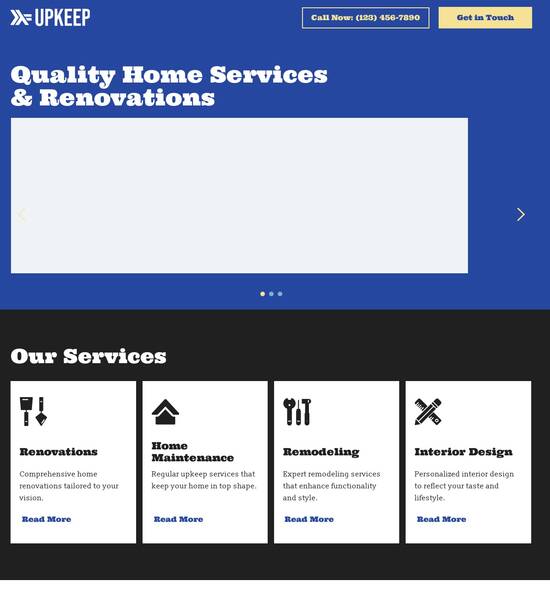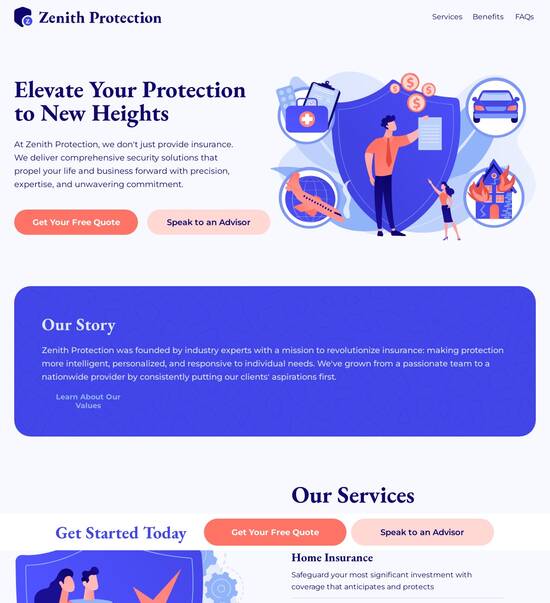
HTML/CSS optimized service unavailable page template
Explore Similar TemplatesAbout template
Supercharge your service unavailable page with HTML/CSS for outstanding performance! Learn more today.
Recommended templates

Easy to build without coding
With the intuitive drag-and-drop builder, anyone on your team can create high-converting pages without any knowledge of code or design. Make enhancements to your landing page with custom widgets using Javascript, HTML/CSS, or third-party scripts.

Multiple layouts for any industry and goal
Select from 500+ landing page layouts built to boost conversions across industry-specific scenarios. Customize them by adjusting fonts, adding images, and generating on-brand content with the AI assistant. Quickly scale with Instablocks® and Global Blocks that you can save, reuse, and update globally.

Loads fast and looks polished on any device
Every template is responsive, which means they present professionally on any device and load blazingly fast with our Thor Render Engine. You can also power them up with Google AMP technology to deliver an unparalleled mobile experience and drive higher conversions.

Robust analytics & experimentation
Get real-time updates and reporting across all your devices, showing the number of visitors, conversions, cost-per-visitor, and cost-per-lead. Launch AI-powered experiments, run A/B tests, and use heatmaps to analyze user behavior, then optimize your landing page to maximize conversions.







Easy to build without coding
With the intuitive drag-and-drop builder, anyone on your team can create high-converting pages without any knowledge of code or design. Make enhancements to your landing page with custom widgets using Javascript, HTML/CSS, or third-party scripts.
Multiple layouts for any industry and goal
Select from 500+ landing page layouts built to boost conversions across industry-specific scenarios. Customize them by adjusting fonts, adding images, and generating on-brand content with the AI assistant. Quickly scale with Instablocks® and Global Blocks that you can save, reuse, and update globally.
Loads fast and looks polished on any device
Every template is responsive, which means they present professionally on any device and load blazingly fast with our Thor Render Engine.
Robust analytics & experimentation
Get real-time updates and reporting across all your devices, showing the number of visitors, conversions, cost-per-visitor, and cost-per-lead. Launch AI-powered experiments, run A/B tests, and use heatmaps to analyze user behavior, then optimize your landing page to maximize conversions.
All the features you need to build lead-generating landing pages
Explore more featuresLearn how to build top-performing landing pages for any goal
FAQs
Leading the way in building high-performing landing pages





A step-by-step guide to leveraging Instapage for landing page optimization
In the competitive landscape of digital marketing, optimizing landing pages is crucial for maximizing ROI. Instapage offers marketers a powerful all-in-one platform that enhances your campaign's performance. With easy access to high-converting templates and robust optimization features, Instapage enables quick page creation and conversion rate improvement tailored for specific audiences, particularly in sectors like tech, education, and financial services.
Understanding the power of Instapage
Instapage is designed to streamline your landing page creation process, making it user-friendly for teams of all sizes. Leveraging over 100 customizable templates, users can launch pages faster than ever. The platform’s optimization capabilities, including A/B testing and detailed analytics, ensure that your campaigns continuously evolve for better performance. Whether you are in marketing or finance, Instapage helps tailor your approach to maximize engagement and conversion.
- Instant access to high-quality templates: Jumpstart your campaigns with professional templates that are proven to convert.
- Robust collaboration tools: Work seamlessly with your team to provide real-time feedback and edits, significantly speeding up your workflow.
- Advanced personalization options: Ensure your pages resonate with target audiences by delivering tailored experiences.
Step 1: Choose the right template
Begin by selecting an appropriate template that aligns with your campaign goals. Instapage’s library offers a variety of layouts focused on different objectives.
- Understand your audience: Choose a template that speaks directly to the needs of your target demographic.
- Prioritize mobile optimization: Make sure the chosen template is responsive, catering to users on all devices.
- Focus on conversion elements: Look for templates that are designed with conversion in mind, including lead capture forms and call-to-action buttons.
Step 2: Customize and optimize your landing page
Once your template is selected, it’s time to personalize and optimize your page. Utilize Instablocks to easily adjust elements without coding.
- Add dynamic text replacement: Personalize content based on user data to enhance engagement and conversion.
- Utilize A/B testing: Regularly test different versions of your page to identify which elements perform best.
- Incorporate analytics: Use Instapage’s dashboard to monitor user behavior and adjust your strategy accordingly.
Step 3: Launch and iterate for improvement
After finalizing your design, publish the landing page and track its performance closely. Instapage’s built-in metrics will help you understand visitor interactions.
- Evaluate key performance indicators (KPIs): Regularly review conversion rates, bounce rates, and lead captures.
- Solicit feedback: Engage with your audience for direct insights into page performance.
- Iterate based on data: Use the gathered data to refine your pages continuously and enhance results.
By following these steps, you can create landing pages that not only attract visitors but also convert them into leads and sales.
Ready to maximize your marketing efforts? Start using Instapage today for a streamlined landing page solution crafted to elevate your campaigns!
People also ask about HTML/CSS optimized service unavailable page template
HTML/CSS Optimized Service Unavailable Page Template
Understanding the concepts behind service unavailable page templates
Creating an optimized service unavailable page is crucial for both user experience and brand reputation. Such pages serve a specific purpose, primarily when a user encounters the HTTP Error 503, which means 'Service Unavailable.' This error indicates that the web server cannot handle requests momentarily, often due to maintenance or overloading. Given the reliance on websites for business, understanding the significance of these pages is essential.
The significance of an optimized service unavailable page
When users find themselves faced with a service unavailable page, projecting transparency and reassurance is paramount. An optimized service unavailable page helps communicate the status of the website and provides users with expectations on when they can return. In addition, how effectively a business handles downtime can greatly impact user trust. At the heart of it, websites should prioritize user experience, even during disruptions.
Defines the immediate response and expectations for users.
Maintains user loyalty by reinforcing effective communication.
Protects the business’s online reputation from negative impressions.
Core components of a service unavailable page
A well-structured service unavailable page consists of three primary components: HTML structure, CSS styling, and content strategies. Paying attention to each aspect ensures that users receive a clear, visually appealing message, even when the website is down.
HTML Structure
Utilizing semantic HTML enhances clarity and helps screen readers interpret the page. Key HTML elements include , , , etc.
CSS Styling
Effective color schemes and fonts must align with the brand. Ensuring the page is responsive across devices enhances accessibility.
Content Strategies
Clear messaging about the status while providing interaction options like social media links or contact forms can keep users engaged.
Technical considerations in development
Understanding the technical aspects related to server configuration and application pools can enhance the functionality of service unavailable pages. An application pool isolates the web applications on an IIS server, ensuring one application doesn’t disrupt another. Optimally configuring server resources can significantly reduce downtime and improve recovery time.
Effectively managing configuration files results in sharper error handling.
Temporary maintenance modes allow for controlled environment update without frustrating users.
Custom error pages help reinforce brand identity during errors like 404 and 503.
Design and development best practices
Engaging with developer communities can provide a wealth of creative ideas for service unavailable page templates. Studying successful implementations can offer insights into common pitfalls and best practices. It’s essential to ensure that your page maintains a consistent experience across different browsers and devices, using progressive enhancement techniques to ensure optimal functionality for all users.
Review case studies that exhibit effective handling of service downtime.
Utilize browser compatibility tools to test the service unavailable page across platforms.
Incorporate SEO strategies to protect SERP rankings during downtime.
Technological enhancements
Using JavaScript can add interactive elements like timers or countdown clocks to a service unavailable page. This can create a sense of urgency and engagement, which helps ease user frustration. API calls that show real-time updates can improve the user experience by allowing users to know when the service is expected to return without unnecessary refreshes.
Incorporate interactive elements to foster user engagement.
Utilize server-side languages to create dynamic content as the status changes.
Frameworks like React or Vue can streamline development processes.
Analyzing user behavior and feedback
Utilizing analytics tools can provide insights into how users interact with the service unavailable page. Monitoring trends in user engagement allows businesses to identify pain points and make necessary adjustments. Implementing feedback mechanisms, such as contact forms, can further improve user satisfaction during downtime.
Track user behavior with analytics tools to understand drop-off rates.
Analyze user feedback to inform future improvements.
Address common issues promptly to maintain trust.
Looking ahead: future trends in error page optimization
As technology evolves, there is potential for integrating AI and machine learning to predict and manage downtime effectively. Enhanced customization through user behavior analytics can allow businesses to tailor their service unavailable page experiences. Innovative technologies such as augmented reality could redefine how businesses interact with users even during service outages.
Explore AI tools for predictive maintenance management.
Utilize user analyses to build personalized error experiences.
Investigate integration of modern tools like AR for improved communication.
Implementing a robust testing protocol
To ensure a service unavailable page is effective, a thorough testing protocol is necessary. A/B testing allows marketers to experiment with different layouts and content styles, gaining feedback on user interactions. User experience research can validate the clarity of communication and the ease of navigation during frustrating times.
Implement A/B testing to optimize templates based on user feedback.
Simulate downtime scenarios for thorough testing of the template.
Utilize virtual testing environments to assess page performance.
Showcasing successful examples
Highlighting case studies from well-known brands that successfully managed downtime can provide a wealth of information. Analyzing their service unavailable pages, including content and design elements, allows others to replicate best practices. These successful instances often elicit positive responses, reinforcing the importance of well-designed error pages.
Review notable brands that manage downtime effectively.
Analyze the design choices that make their error pages engaging.
Learn from the content strategies that maintain user trust during outages.
Ready to skyrocket conversions?
Supercharge your ad campaigns with high-performing landing pages
Get started














